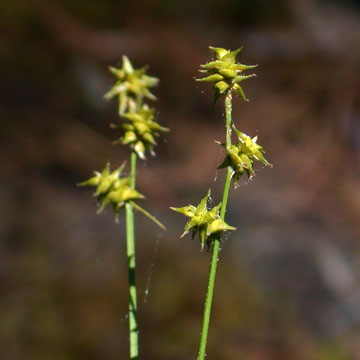

Carex echinata - (image 1 of 3)
Taxonomy
Family: Cyperaceae
Section Stellulatae
Habitat
Swamps, bogs, fens, and other wet places.
Associates
Distribution
Circumboreal, south to VA and in mountains to NC, IN, IA, UT, and CA. Eastern plants are ssp. echinata
Morphology
Tufted perennial; stems 10-60 cm, scabrous on the angles above, aphyllopodic; leaves plicate, mostly 1-2.5 mm wide; spikes 3-7, sessile, small and few-flowered, the terminal one with a slender staminate base, some of the lateral ones often wholly pistillate; bracts small and inconspicuous; perigynia 5-15, crowded, widely spreading or the lower reflexed, green or tan, planoconvex, spongy-thickened at the base, narrowly lance-triangular to more often lance-ovate or even ovate, 2.8-3.5(-4) mm, 1.8-3.2 times as long as wide, often serrulate-margined distally, with a prominent, slender, serrulate-margined, sharply bidentate beak 1-1.6 mm, half as long to almost as long as the body; achene lenticular.
Notes
Fruiting late May to July
Wetland indicator: OBL
This species is highly variable and can have spikes with few or several perigynia, and the spikes can be congested or widely spaced on the culm. Similar to C. interior and C. atlantica which have shorter or relatively wider perigynia and the beak only up to half as long as the body.
References
Gleason, Henry A. and A. Cronquist. 1991. Manual of Vascular Plants of
Northeastern United States and Adjacent Canada. Second Ed.
The New York Botanical Garden. Bronx, NY
|
© Michael Hough 2018 |